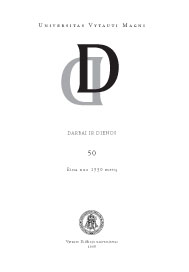MORFOLOGINIŲ SAMPLAIKŲ STRUKTŪROS YPATUMAI: KELIŲ KALBŲ PALYGINIMAS
STRUCTURAL FEATURES OF MULTIWORD EXPRESSIONS: A MULTILINGUAL APPROACH
Author(s): Erika Rimkutė, Jolanta KovalevskaitėSubject(s): Language and Literature Studies
Published by: Vytauto Didžiojo Universitetas
Keywords: morfologinės samplaikos; žodžių junginiai; sakytinė kalba; rašytinė kalba; multiword expressions; compounds; spoken language; written language
Summary/Abstract: Multiword expressions are defined as a type of fixed expressions or collocations consisting of two or more words that form a semantically and syntactically unified, non-compositional whole, a unit that performs one syntactic function. The present paper deals with a multilingual comparative investigation that tackles the question of systemic translation equivalents. The aim of the investigation is to find out whether Lithuanian multiword expressions preserve their form of an expression in the English, German, Czech, and Russian languages. The term “multiword expression” implies the existence of a few words that can be presented, depending upon a specific language, in one of a few different ways: either as a set of two or more words spelled separately or a hyphenated word combination or a compound. As such it is opposed to and translated as a non-compound word, e.g. Lt ką tik – De eben, Lt be to – En again, Lt taip pat – Cz – taky, Lt be abejo – Ru конечьно. In order to be able to compare multiword expressions in different languages they were classified semantically and syntactically since similar meaning and syntactic function was a common basis for comparison. A few most frequently used multiword expressions were selected from each type of the classification (36 all in all) and supplied with their translation equivalents in the above-mentioned languages. Translation dictionaries and parallel corpora were used for the compilation of a DB of multilingual expressions and their equivalents in five languages. The analyses of the DB showed that in most cases Lithuanian multiword expressions are translated by multiword expressions of other languages, in the case of English they make up 56,8 %, in German 12,6 %, in Russian 92,4 %, in Czech 40 %. Multiword translation equivalents can be compounds, a few separate or hyphenated word expressions. Compound translation equivalents are typical of German language (41 %); hyphenated multiword translation equivalents are most frequent in Russian (10 %). A comparative semantic analysis of multiword units is the next step of the investigation. It is of paramount importance not only from the theoretical point of view but also in practice, i.e. for automated translation or machine translation systems, automated text analysis, and natural language processing.
Journal: Darbai ir dienos
- Issue Year: 2009
- Issue No: 50
- Page Range: 120-156
- Page Count: 38
- Language: Lithuanian

